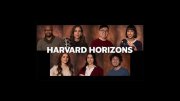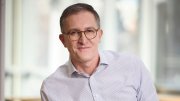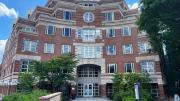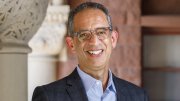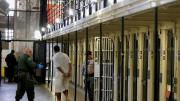Delivering brief presentations on subjects from infrastructural aesthetics to aliens, seven Harvard Horizons scholars shared their research to an enthusiastic Sanders Theater crowd. The students had been selected in what Graduate School of Arts and Sciences (GSAS) Dean Emma Dench described as a “fierce competition” across 57 graduate programs. The seven winners, who spoke this Tuesday, received ten weeks of presentation coaching as part of this opportunity to speak about their work. Before she introduced the speakers, Dench alerted the crowd of the “tight-rope walk,” the scholars would soon perform. “They will have just five minutes to share with us their own highly original, cutting-edge research in terms that all of us can understand, no matter what our background is,” she said. “And they will make it look easy.”
Vanessa Braganza of the English department led off the night by discussing her research in deciphering codes, and particularly the story of Mary, Queen of Scots. Mary, held in captivity for 18 years by Elizabeth I of England, her first cousin once removed, created a disguised writing system that she used when corresponding about a plot to kill Elizabeth. Mary’s codes were deciphered, and the plot was foiled; she would be killed. “These two examples barely scratch the surface of the unplumbed archive of Mary’s codes,” Braganza said, “and Mary’s story barely scratches the surface of the dangerous games that people were playing with codes in the Renaissance.” In her work deciphering codes, Braganza seeks to search for the “secret passageways and trap doors of history,” she said. “And that’s what I do as a literary historian—or as I like to think of it—as a book detective.”
Another English presenter, Karina Mathew, had a different focus: extraterrestrial life. She discussed how human-extraterrestrial interactions are often displayed in movies and literature with an “anthropocentric bias,” she said, projecting the human onto the extraterrestrial— “viewing the aliens as conquerors, agents of enlightenment, or metaphors for race relations.” Mathew suggested thinking about other aliens, and more broadly other species, on their own terms. “The works of our imagination are a lens as powerful as that of any telescope, that filters what we look for in the night sky, what we see, and what we choose to label as alien or not,” she said. “How we define the parameters of the extraterrestrial may mean the difference between making contact and staring blindly into the night.”
Juliana García-Mejía of the astronomy department took discussion of extraterrestrial life from the philosophical to the scientific. She discussed her work at the Tierras Observatory—atop Mount Hopkins in Santa Cruz County, Arizona—where she has helped refurbish a massive telescope that she has specially outfitted to filter certain wavelengths to increase its field of view and allow her team to monitor many more stars, and the planets near them. The group’s goal is to use the modified device to find planets outside of our solar system that are similar to earth.
Nicolò Foppiani of the physics department also explored new ground. His research centers on the neutrino—hard-to-detect but omnipresent subatomic particle similar to electrons, but with no electric charge. Foppiani is on the hunt for the “sterile” neutrino, an undiscovered breed of the particle that does not interact like the others. In his research, Foppiani analyzes large data sets of subatomic particle interactions, breaking them down through complex algorithms to find evidence of the sterile neutrino. “So why am I doing this?” Foppiani asked, to a laugh from the crowd. “To discover the sterile neutrino would mean so much more to physics than simply discovering a new particle.” It could help reveal the secrets of dark matter, which composes 80 percent of the universe, but can be detected only through its gravitational influence.
From the economics department, Chika Okafor also broke down large data sets—but with a focus on crime. In his research, he sought to determine whether elected prosecutors between 1986 and 2006 put more people behind bars in an era where many politicians wanted to be seen as “tough on crime.” He found a heavy link between pro-white bias and heavier sentences. While many see policy as the only answer to these disparities, Okafor argued that public sentiment is just as important—or even more so. “Our challenge as a nation is to balance the concern for safety and security with the acknowledgment of the humanity of all people,” he said, “including the incarcerated.”
In his research, Harim Won of biological sciences in public health confronted another issue: drug-resistant tuberculosis. While drugs have greatly improved the survival rate of tuberculosis patients, they have also led to multidrug-resistant strains with a cure rate of just 56 percent. Won’s lab is trying to solve this issue with “targeted protein degradation,” which attaches bispecific molecules to both sides of disease-causing proteins that flag them as trash for the body to clear away. It’s his hope that this process can help greatly reduce the amount of antibiotics needed to counter tuberculosis—and maybe eliminate the disease altogether.
Hannah Cohen, of art, film, and visual studies, spoke about an often-underappreciated element of art: the infrastructure that allows it to exist. “We often think about art in romantic terms, as something privileged and pristine, something removed from the fabric of everyday life,” she said. “But the fact is that it’s anything but. It’s technical.” She studies the technical specialists, systems, and knowledge that shape the scope and possibilities of modern art—like the complex engineering that allowed the Tate Modern galleries to install a massive crack in its floor without compromising the museum’s structural integrity.
The Harvard Horizons scholars will have another chance to present their work at Expanded Horizons, on May 17. This time, online.
